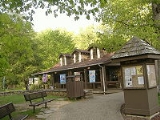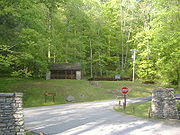
Carter Caves State Resort Park
Encyclopedia
Carter Caves State Resort Park is located in Carter County
, Kentucky
, United States
, along Tygarts Creek
. It is formed by Carter Caves, and nearby Cascade Caves, which were added to the park in 1959. On December 16, 1981, 146 acre (0.59084156 km²) of the park were designated as nature preserves. Bat Cave and Cascade Caverns State Nature Preserves
were dedicated for the protection of the Indiana bat
, mountain maple
, and Canada yew
, all endangered species
.
was in various private hands for almost 200 years until the last private family owners, the J.F. Lewis family and various other private investors, including local Rotary Clubs
, donated the large tract of property to the Commonwealth of Kentucky in 1946. The purchase of the caves and surrounding land was driven by Governor William Jason Fields, a native of Carter County.
 There are several different Cave Tours offered. All caves, except guided tours of Cascade Cave and X-Cave, have been closed until further notice due to the threat of White nose syndrome
There are several different Cave Tours offered. All caves, except guided tours of Cascade Cave and X-Cave, have been closed until further notice due to the threat of White nose syndrome
, a disease which threatens several endangered species of bats.
Cascade Cave is the name for 3 different caves in the same area and is together the largest cave in the park. It features an underground lake room and an 30 feet (9.1 m) underground waterfall.
X Cave, named for the crossing pattern of its passages, features some of the largest rock formations in the park.
Saltpetre Cave was mined during the War of 1812 because saltpetre, or potassium nitrate, is a major component in gun powder. Historic activities are a major part of the Saltpetre Cave tour. Bat Cave is also toured in the summer months, between Memorial Day and Labor Day, and is considered a "wild" cave tour since the cave has not been improved for walking tours. The cave is unique in that it is a hibernaculum for the Indiana Bat in the winter months. Bat Cave and Saltpetre Cave are both closed until further notice because a rare bat disease called White nose syndrome
is getting closer to Kentucky.
Laurel Cave is the most visited of the non-commercial caves in the park, but contains some of the most interesting passages.
Laurel Cave is open to the public during regular business hours in the summer months only (Memorial Day - Labor Day). All that is required is a permit available at the Welcome Center/Gift Shop. The permit gives you legal access to Laurel Cave (Summer Months Only), Horn Hollow Caves and the connected Rimstone Cave.
 Over thirty miles of hiking trails encounter seven natural bridges throughout the park. The Cascade Trail is a three-quarter mile trail passing through Box Canyon. The Three Bridges Trail winds three and a quarter miles and includes the park's largest natural bridge, the Smokey Bridge, which stands an impressive 90 feet (27.4 m) high and 120 feet (36.6 m) wide. This trail also passes by Fern Bridge and Raven Bridge as it meanders through the park. The half-mile Natural Bridge Trail passes beneath a third natural bridge, the only one in Kentucky that is paved and supports traffic. Longer trails include the 7.2 miles (11.6 km) Carter Caves Cross Country Trail (The 4Cs Trail) and the ten mile (16 km) Kiser Hollow multi-access trail, which parallels the 4Cs trail for a couple of miles before encircling the outer boundaries of the park's property.
Over thirty miles of hiking trails encounter seven natural bridges throughout the park. The Cascade Trail is a three-quarter mile trail passing through Box Canyon. The Three Bridges Trail winds three and a quarter miles and includes the park's largest natural bridge, the Smokey Bridge, which stands an impressive 90 feet (27.4 m) high and 120 feet (36.6 m) wide. This trail also passes by Fern Bridge and Raven Bridge as it meanders through the park. The half-mile Natural Bridge Trail passes beneath a third natural bridge, the only one in Kentucky that is paved and supports traffic. Longer trails include the 7.2 miles (11.6 km) Carter Caves Cross Country Trail (The 4Cs Trail) and the ten mile (16 km) Kiser Hollow multi-access trail, which parallels the 4Cs trail for a couple of miles before encircling the outer boundaries of the park's property.
, bluegill, catfish, and crappie in the lake. The boat is accessible by ramp, but no gasoline motors are permitted.
Carter County, Kentucky
Carter County is a county located in the U.S. state of Kentucky. It was formed in 1838 and was named for William Grayson Carter, a state senator at the time of its creation. The county seat is named for his uncle, Robert Grayson. As of 2000, the population was 26,889. Its county seat is Grayson,...
, Kentucky
Kentucky
The Commonwealth of Kentucky is a state located in the East Central United States of America. As classified by the United States Census Bureau, Kentucky is a Southern state, more specifically in the East South Central region. Kentucky is one of four U.S. states constituted as a commonwealth...
, United States
United States
The United States of America is a federal constitutional republic comprising fifty states and a federal district...
, along Tygarts Creek
Tygarts Creek
Tygarts Creek is a tributary of the Ohio River, about long, in northeastern Kentucky in the United States. Via the Ohio, it is part of the watershed of the Mississippi River...
. It is formed by Carter Caves, and nearby Cascade Caves, which were added to the park in 1959. On December 16, 1981, 146 acre (0.59084156 km²) of the park were designated as nature preserves. Bat Cave and Cascade Caverns State Nature Preserves
Bat Cave and Cascade Caverns State Nature Preserves
Bat Cave and Cascade Caverns State Nature Preserves are two nature preserves totaling located within the boundaries of Carter Caves State Resort Park in Carter County, Kentucky. Bat Cave was dedicated into the Kentucky State Nature Preserves Commission system on Dec 16 1981 for the protection of...
were dedicated for the protection of the Indiana bat
Indiana bat
The Indiana bat is a medium-sized mouse-eared bat native to North America. It lives primarily in eastern and midwestern states and in parts of the south of the United States. The Indiana bat is gray, black, or chestnut in colour and is 1.2–2 inches and weighs about 1/4 an ounce...
, mountain maple
Mountain Maple
Acer spicatum is a species of maple native to northeastern North America from Saskatchewan to Newfoundland, and south to Pennsylvania. It also grows at high elevations in the southern Appalachian Mountains to northern Georgia....
, and Canada yew
Taxus canadensis
Taxus canadensis is a conifer native to central and eastern North America, thriving in swampy woods, ravines, riverbanks and on lake shores. Locally called simply "Yew", this species is also referred to as American Yew or Ground-hemlock.Most of its range is well north of the Ohio River...
, all endangered species
Endangered species
An endangered species is a population of organisms which is at risk of becoming extinct because it is either few in numbers, or threatened by changing environmental or predation parameters...
.
History
The parkState park
State parks are parks or other protected areas managed at the federated state level within those nations which use "state" as a political subdivision. State parks are typically established by a state to preserve a location on account of its natural beauty, historic interest, or recreational...
was in various private hands for almost 200 years until the last private family owners, the J.F. Lewis family and various other private investors, including local Rotary Clubs
Rotary International
Rotary International is an organization of service clubs known as Rotary Clubs located all over the world. The stated purpose of the organization is to bring together business and professional leaders to provide humanitarian service, encourage high ethical standards in all vocations, and help...
, donated the large tract of property to the Commonwealth of Kentucky in 1946. The purchase of the caves and surrounding land was driven by Governor William Jason Fields, a native of Carter County.
Resort park
Carter Caves is a state resort park that features a lodge, cottages, 18 hole putt-putt course, 9 hole golf course, full-service campground (18 sites now have sewer hook-ups), and immense natural beauty. It has various cave tours available year round that displays and explains the wonders of the underground world. It also has seasonal horse riding stables.It is well known for its splendor above and below ground.Caves

White nose syndrome
White nose syndrome is a poorly understood disease associated with the deaths of more than a million bats. The condition, named for a distinctive fungal growth around the muzzles and on the wings of many affected animals, was first identified in a cave in Schoharie County, New York, USA, in...
, a disease which threatens several endangered species of bats.
Cascade Cave is the name for 3 different caves in the same area and is together the largest cave in the park. It features an underground lake room and an 30 feet (9.1 m) underground waterfall.
X Cave, named for the crossing pattern of its passages, features some of the largest rock formations in the park.
Saltpetre Cave was mined during the War of 1812 because saltpetre, or potassium nitrate, is a major component in gun powder. Historic activities are a major part of the Saltpetre Cave tour. Bat Cave is also toured in the summer months, between Memorial Day and Labor Day, and is considered a "wild" cave tour since the cave has not been improved for walking tours. The cave is unique in that it is a hibernaculum for the Indiana Bat in the winter months. Bat Cave and Saltpetre Cave are both closed until further notice because a rare bat disease called White nose syndrome
White nose syndrome
White nose syndrome is a poorly understood disease associated with the deaths of more than a million bats. The condition, named for a distinctive fungal growth around the muzzles and on the wings of many affected animals, was first identified in a cave in Schoharie County, New York, USA, in...
is getting closer to Kentucky.
Laurel Cave is the most visited of the non-commercial caves in the park, but contains some of the most interesting passages.
Laurel Cave is open to the public during regular business hours in the summer months only (Memorial Day - Labor Day). All that is required is a permit available at the Welcome Center/Gift Shop. The permit gives you legal access to Laurel Cave (Summer Months Only), Horn Hollow Caves and the connected Rimstone Cave.
Trails

Smokey Valley Lake and Tygarts Creek
Smokey Valley Lake is a 45 acres (182,108.7 m²) lake within the park. Anglers will find populations of largemouth bassLargemouth bass
The largemouth bass is a species of black bass in the sunfish family native to North America . It is also known as widemouth bass, bigmouth, black bass, bucketmouth, Potter's fish, Florida bass, Florida largemouth, green bass, green trout, linesides, Oswego bass, southern largemouth...
, bluegill, catfish, and crappie in the lake. The boat is accessible by ramp, but no gasoline motors are permitted.
External links
- Carter Caves Crawl-a-thon (link dead as of 2011-07-30)
- Carter Caves State Resort Park at American Byways
- Carter Caves State Resort Park at Kentucky Parks

